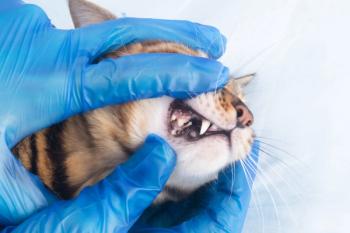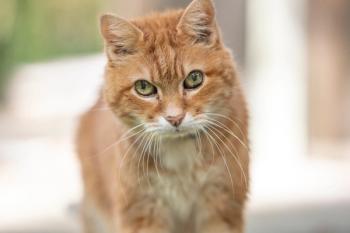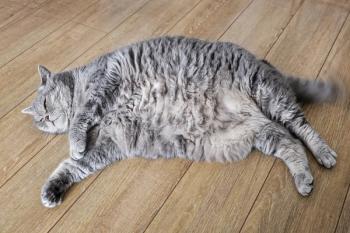
Feline viral skin diseases (Proceedings)
Feline herpesvirus1 infection is most noted for causing URI disease and oral ulceration. Latent, persistent infection will occur in about 30% of affected cats. Vaccines do not prevent feline herpesvirus infection nor carriage or intermittent shedding of the virus. Recrudescence of signs or new lesions may occur with stress or concurrent illness.
Feline Herpesvirus Dermatitis
Feline herpesvirus1 infection is most noted for causing URI disease and oral ulceration. Latent, persistent infection will occur in about 30% of affected cats. Vaccines do not prevent feline herpesvirus infection nor carriage or intermittent shedding of the virus. Recrudescence of signs or new lesions may occur with stress or concurrent illness. Virus usually resides in the trigeminal ganglion and the distribution of lesions usually follows the distribution pattern of this nerve.
Lesions in cats without URI signs are often found on the haired skin of the nasal planum, head, face, or ears. The feet and ventrum may be less commonly affected.
Given the pattern of the lesions, the most common DDx for Herpesvirus dermatitis are: mosquito hypersensitivity, EGC, SCC, and allergic or parasitic dermatitis.
Microscopic examination of lesions reveals ulceration and nectosis with an inflammatory infiltrate that may contain many eosinophils hence the confusion with EGC and parasitic lesions. The intranuclear inclusion bodies characteristic of herpesvirus may be difficult to find. It may be necessary to send tissue for immunohistochemistry or PCR on tissue biopsy samples. Confirmation of the diagnosis is important because immunosuppressive drugs can worsen this condition.
Treatment of herpesvirus dermatitis:
L-lysine 250-500 mg PO q12h
IFNα:
30-30K U PO q24h
250-500K U SQ 3X/wk for 6 weeks
Lactoferrin? 350 mg PO q24h
Acyclovir: Not effective against FHV1
Famcyclovir: 32 mg (¼ of 125 mg tablet) PO q12h
Imiquimod (Aldara®) 5% cream
Topical immunomodulator
Apply to lesions q48-72h
The prognosis for herpesvirus dermatitis is guarded because the viral infection will persist, lesions are difficult to resolve, and recrudescence is comon.
FHV1 may be related Idiopathic Ulcerative dermatitis (see below) due to paraesthesia of the nerves in the head and neck that results in self-mutilation.
Idiopathic Ulcerative Dermatitis
May be related to FHV1 as noted above.
Attempts at treatment have included:
•Surgical removal of affected skin
•Corticosteroids: Depo-Medrol® 20 mg IM q2weeks until healed
•Behavior modifying drugs
•Bandaging, topical anti-inflammatory drugs, Soft Paws® nail covers
•Gabapentin?
Feline Calicivirus
Usually causes an URI syndrome similar to FHV1. Oral ulcerations are common but corneal ulcerations are not seen. Virulent systemic feline calicivirus (VS-FCV) may cause ulceration and skin sloughing associated with the vasculitis seen with this rare but severe form of calicivirus. The face and limbs are most commonly affected with VS-FCV skin lesions. Vaccines do not prevent infection with FCV or VS-FCV, nor prevent chronic carriage. About 25% of FCV-infected cats become chronic carriers and viral shedding is continuous.
The most common chronic clinical syndromes are gingivostomatitis and tooth extrusion. A recent report described a post-surgical pustular dermatitis associated with calicivirus in two cats post OHE.
Retrovirus-associated Dermatitis
Unique FeLV dermatitis
FeLV can directly cause a rare but unique dermatosis usually affecting the head and neck. The condition is a crusting, alopecic, and sometimes pruritic dermatosis. Histologic examination of affected tissue shows a giant-cell inflammatory infiltrate. There is no effective treatment.
Cutaneous Horn
Cutaneous horns are exuberant, avascular growths of keratin. They are often asymptomatic and are discovered by owners or on routine veterinary examinations. The footpads/feet are most commonly involved. Lesions may occur on the ears, particularly in association with dermal squamous cell carcinoma (SCC). FeLV-infection may be present in affected cats.
Treatment includes periodic trimming of growths to prevent interference with mobility. If the horns are painful and growing from the pads, excision of the base of the lesions may be needed to prevent recurrence. If the lesions are associated with SCC, the neoplastic lesions should be excised, or otherwise managed.
Feline Immunodeficiency Virus (FIV)
A non-pruritic, generalized, papulocrustous eruption with alopecia and scaling, most severe in the head and limbs, has been reported in FIV-infected cats. Histopathologic examination of the skin demonstrates hydropic interface dermatitis with occasional giant keratinocytes. No treatment benefited the cats. A severe form of mucinous degenerative mural folliculitis has also been reported in cats infected with FIV. No treatment has been reported to be effective.
However, skin disease found in FIV-infected cats is often a secondary problem (fungal, bacterial, parasitic) and many of these conditions are treatable. Remember your routine dermatologic diagnostic tools including skin scrapings, cytologic examination, Wood's light examination and fungal culture, bacterial culture, and biopsy.
Papillomavirus
There are several dermatologic syndromes associated with feline papillomavirus infection. Cats do not typically develop oral warts as do dogs.
Bowen's Disease
Bowen's disease (multicentric SCC in situ) occurs most commonly in middle-aged to older cats. The lesions appear as elevated, irregular plaques occurring in haired, pigmented skin not commonly associated with actinic (solar) dermatitis. The disease does not typically extend beyond the dermis and metastatic lesions have not been reported.
Feline Sarcoid
Formerly known as fibropapillomatosis, feline sarcoid is very similar in pathogenesis to equine sarcoid. The face, head, and limbs are frequently affected.
Treatment for both conditions is similar. Surgical removal is the recommended approach to treatment and lasers are very effective for this. For Bowen's disease topical 5-FU (caution! in cats) and isotretinoin. Other reported therapies include topical Imiquimod cream and radiation therapy.
Catpox (Cowpox)
Catpox is an orthopoxvirus whose primary host is cattle. This condition occurs primarily in the UK and EU. The reservoir of infection is the small rodent population mostly voles and mice. Cats become accidently infected due to their hunting activities.
There is a primary lesion at the site of viral inoculation. Secondary lesions appear in 4-16 days and usually involve the head, neck, forelimbs, and paws, areas most subject to bites and scratches from their rodent prey.
The diagnosis is made by histopathology and these nodular lesions must be distinguished from much more common nodular dermatoses caused by fungi, bacteria, or neoplastic disease. There is no specific treatment but most cats will spontaneously recover in 3-4 weeks. This is a potential zoonosis.
Newsletter
From exam room tips to practice management insights, get trusted veterinary news delivered straight to your inbox—subscribe to dvm360.






